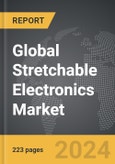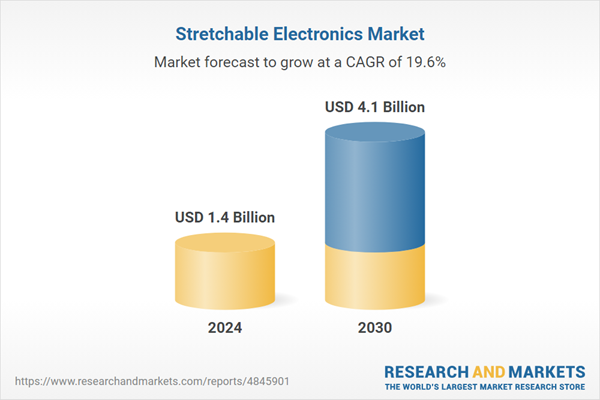The global market for Stretchable Electronics was valued at US$1.4 Billion in 2024 and is projected to reach US$4.1 Billion by 2030, growing at a CAGR of 19.6% from 2024 to 2030. This comprehensive report provides an in-depth analysis of market trends, drivers, and forecasts, helping you make informed business decisions. The report includes the most recent global tariff developments and how they impact the Stretchable Electronics market.
Segments: Application (Consumer Products, Automotive Electronics, Aerospace & Defense, Healthcare, Other Applications).
Geographic Regions/Countries: World; United States; Canada; Japan; China; Europe (France; Germany; Italy; United Kingdom; Spain; Russia; and Rest of Europe); Asia-Pacific (Australia; India; South Korea; and Rest of Asia-Pacific); Latin America (Argentina; Brazil; Mexico; and Rest of Latin America); Middle East (Iran; Israel; Saudi Arabia; United Arab Emirates; and Rest of Middle East); and Africa.
The analysts continuously track trade developments worldwide, drawing insights from leading global economists and over 200 industry and policy institutions, including think tanks, trade organizations, and national economic advisory bodies. This intelligence is integrated into forecasting models to provide timely, data-driven analysis of emerging risks and opportunities.
Global Stretchable Electronics Market - Key Trends and Drivers Summarized
Why Are Stretchable Electronics Emerging as a Key Technology in Wearables and Medical Devices?
Stretchable electronics are gaining prominence as they enable the creation of devices that can bend, stretch, and conform to different shapes while maintaining their functionality. This capability is essential for developing wearable electronics, biomedical devices, and flexible displays that need to withstand dynamic movements and deformations. Stretchable electronics are increasingly being used in healthcare for applications such as skin-mounted sensors, implantable devices, and smart textiles. The growing demand for lightweight, flexible, and unobtrusive electronics that can monitor health metrics or enhance user comfort is driving the adoption of stretchable electronics in various industries.What Technological Advances Are Propelling Stretchable Electronics?
Technological advancements in materials science, microelectronics, and nanotechnology are driving the innovation of stretchable electronics. New materials, such as stretchable conductive polymers, elastomers, and nanomaterials, are enabling the production of flexible circuits and sensors that can stretch and flex without losing functionality. The integration of these materials with advanced manufacturing techniques, such as 3D printing and microfabrication, is allowing for the creation of stretchable electronic components with greater precision and performance. Additionally, the development of soft robotics and flexible energy storage solutions is expanding the applications of stretchable electronics, particularly in medical, sports, and consumer electronics sectors.Which Market Segments Are Driving the Growth of Stretchable Electronics?
Product types include stretchable sensors, batteries, displays, and circuits, with stretchable sensors and displays leading the market due to their extensive use in wearables and medical devices. Applications of stretchable electronics include healthcare monitoring, sports and fitness, automotive interiors, and consumer electronics, with healthcare and consumer electronics accounting for the largest market shares. End-use industries such as healthcare, automotive, and consumer electronics are the primary drivers of demand for stretchable electronics, fueled by the need for flexible, lightweight, and durable devices. Geographically, North America and Asia-Pacific lead the market, driven by advancements in wearable technology and increasing R&D investments.What Is Driving the Growth of the Stretchable Electronics Market?
The growth in the stretchable electronics market is driven by several factors, including increasing demand for wearable technology, advancements in flexible materials, and growing applications in healthcare and automotive industries. The rising adoption of stretchable electronics in healthcare devices, particularly in monitoring and diagnostic applications, is fueling market growth. Technological innovations in conductive materials and flexible substrates are enabling the development of high-performance stretchable electronics for a variety of industries. Additionally, the expansion of the consumer electronics market and the growing focus on integrating stretchable electronics into everyday products are creating new growth opportunities in the stretchable electronics market.Report Scope
The report analyzes the Stretchable Electronics market, presented in terms of units. The analysis covers the key segments and geographic regions outlined below.Segments: Application (Consumer Products, Automotive Electronics, Aerospace & Defense, Healthcare, Other Applications).
Geographic Regions/Countries: World; United States; Canada; Japan; China; Europe (France; Germany; Italy; United Kingdom; Spain; Russia; and Rest of Europe); Asia-Pacific (Australia; India; South Korea; and Rest of Asia-Pacific); Latin America (Argentina; Brazil; Mexico; and Rest of Latin America); Middle East (Iran; Israel; Saudi Arabia; United Arab Emirates; and Rest of Middle East); and Africa.
Key Insights:
- Market Growth: Understand the significant growth trajectory of the Consumer Products segment, which is expected to reach US$2.7 Billion by 2030 with a CAGR of a 18.6%. The Automotive Electronics segment is also set to grow at 22.4% CAGR over the analysis period.
- Regional Analysis: Gain insights into the U.S. market, valued at $358.7 Million in 2024, and China, forecasted to grow at an impressive 27.0% CAGR to reach $1.2 Billion by 2030. Discover growth trends in other key regions, including Japan, Canada, Germany, and the Asia-Pacific.
Why You Should Buy This Report:
- Detailed Market Analysis: Access a thorough analysis of the Global Stretchable Electronics Market, covering all major geographic regions and market segments.
- Competitive Insights: Get an overview of the competitive landscape, including the market presence of major players across different geographies.
- Future Trends and Drivers: Understand the key trends and drivers shaping the future of the Global Stretchable Electronics Market.
- Actionable Insights: Benefit from actionable insights that can help you identify new revenue opportunities and make strategic business decisions.
Key Questions Answered:
- How is the Global Stretchable Electronics Market expected to evolve by 2030?
- What are the main drivers and restraints affecting the market?
- Which market segments will grow the most over the forecast period?
- How will market shares for different regions and segments change by 2030?
- Who are the leading players in the market, and what are their prospects?
Report Features:
- Comprehensive Market Data: Independent analysis of annual sales and market forecasts in US$ Million from 2024 to 2030.
- In-Depth Regional Analysis: Detailed insights into key markets, including the U.S., China, Japan, Canada, Europe, Asia-Pacific, Latin America, Middle East, and Africa.
- Company Profiles: Coverage of players such as 3M Company, Adidas AG, Cambrios Technologies Corporation, Dow, Inc., DuPont de Nemours, Inc. and more.
- Complimentary Updates: Receive free report updates for one year to keep you informed of the latest market developments.
Some of the 46 companies featured in this Stretchable Electronics market report include:
- 3M Company
- Adidas AG
- Cambrios Technologies Corporation
- Dow, Inc.
- DuPont de Nemours, Inc.
- Koninklijke Philips NV
- Mc10, Inc.
- Palo Alto Research Center Incorporated
- Physical Optics Corporation
- PowerFilm, Inc.
Tariff Impact Analysis: Key Insights for 2025
Global tariff negotiations across 180+ countries are reshaping supply chains, costs, and competitiveness. This report reflects the latest developments as of April 2025 and incorporates forward-looking insights into the market outlook.The analysts continuously track trade developments worldwide, drawing insights from leading global economists and over 200 industry and policy institutions, including think tanks, trade organizations, and national economic advisory bodies. This intelligence is integrated into forecasting models to provide timely, data-driven analysis of emerging risks and opportunities.
What’s Included in This Edition:
- Tariff-adjusted market forecasts by region and segment
- Analysis of cost and supply chain implications by sourcing and trade exposure
- Strategic insights into geographic shifts
Buyers receive a free July 2025 update with:
- Finalized tariff impacts and new trade agreement effects
- Updated projections reflecting global sourcing and cost shifts
- Expanded country-specific coverage across the industry
Table of Contents
I. METHODOLOGYII. EXECUTIVE SUMMARY2. FOCUS ON SELECT PLAYERSIII. MARKET ANALYSISIV. COMPETITION
1. MARKET OVERVIEW
3. MARKET TRENDS & DRIVERS
4. GLOBAL MARKET PERSPECTIVE
UNITED STATES
CANADA
JAPAN
CHINA
EUROPE
FRANCE
GERMANY
ITALY
UNITED KINGDOM
SPAIN
RUSSIA
REST OF EUROPE
ASIA-PACIFIC
AUSTRALIA
INDIA
SOUTH KOREA
REST OF ASIA-PACIFIC
LATIN AMERICA
ARGENTINA
BRAZIL
MEXICO
REST OF LATIN AMERICA
MIDDLE EAST
IRAN
ISRAEL
SAUDI ARABIA
UNITED ARAB EMIRATES
REST OF MIDDLE EAST
AFRICA
Companies Mentioned (Partial List)
A selection of companies mentioned in this report includes, but is not limited to:
- 3M Company
- Adidas AG
- Cambrios Technologies Corporation
- Dow, Inc.
- DuPont de Nemours, Inc.
- Koninklijke Philips NV
- Mc10, Inc.
- Palo Alto Research Center Incorporated
- Physical Optics Corporation
- PowerFilm, Inc.
Table Information
| Report Attribute | Details |
|---|---|
| No. of Pages | 223 |
| Published | April 2025 |
| Forecast Period | 2024 - 2030 |
| Estimated Market Value ( USD | $ 1.4 Billion |
| Forecasted Market Value ( USD | $ 4.1 Billion |
| Compound Annual Growth Rate | 19.6% |
| Regions Covered | Global |









